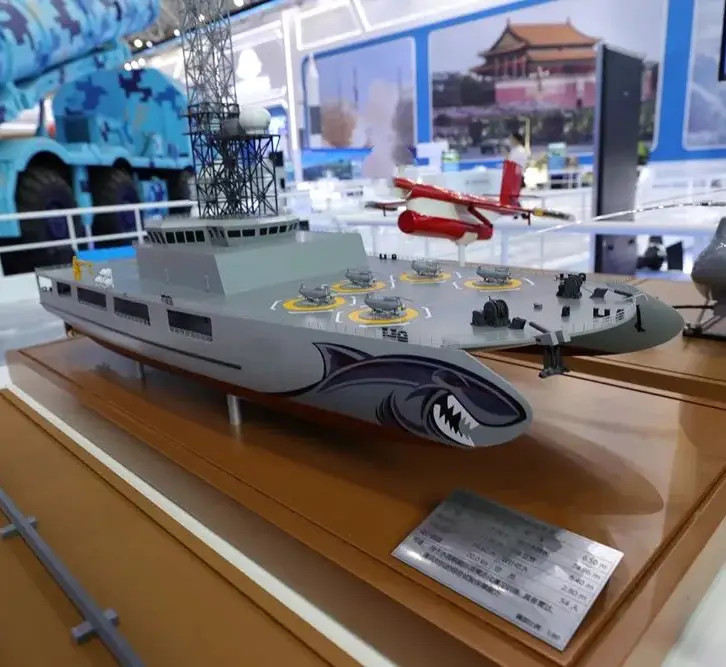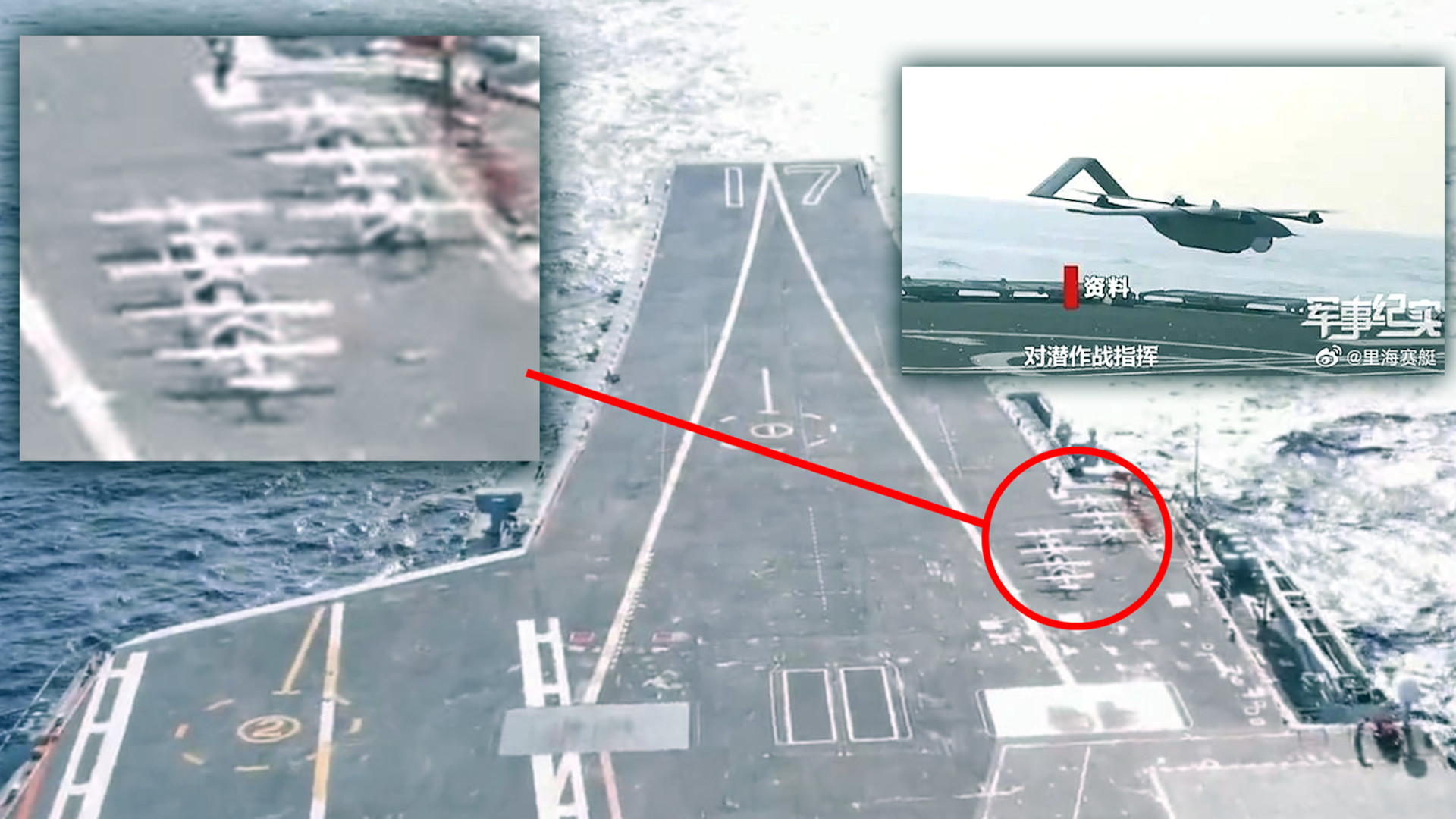Images have emerged online that appear to show multiple examples of at least two different types of commercial or commercial-derivative drones with vertical takeoff and landing capability on the deck of the Chinese aircraft carrier Shandong. The exact circumstances behind these pictures are not immediately clear. They do underscore the Chinese People’s Liberation Army’s ever-increasing efforts to develop and field various types of unmanned aircraft, including those that can operate together in networked swarms, and often with an eye toward performing various roles in the maritime domain.
The images were posted recently on the Chinese microblogging website Weibo, but it’s unclear when they were taken. At least one, which actually shows a drone in flight, has a CCTV-7 watermark, indicating that it is a frame from a segment that aired on that television network. China Central Television’s (CCTV) channel seven is devoted to People’s Liberation Army (PLA) related programming.
In April, Chinese authorities announced that Shandong, which entered service in 2019, had started its first major scheduled maintenance period at Dalian Shipyard. Satellite imagery showed the ship still at Dalian as of at least May 26. The carrier, the first to be constructed domestically in China, had been observed transiting north through the Taiwan Strait in March, timed to coincide with a phone call between Chinese President Xi Jinping and U.S. President Joe Biden, but without any aircraft, manned or unmanned, readily visible on its deck and otherwise appearing to be headed for the shipyard.
Regardless, the pictures of the carrier loaded with these drones are significant. At least two distinct types are visible, but all of them appear to be what are often described as “hybrid” vertical takeoff and landing (VTOL) capable designs. Unmanned aircraft of this general type have relatively conventional fixed-wing configurations and operate as such in level flight, but they also have underwing booms with rotors at each end to enable VTOL operation.
In the picture showing the various drones arrayed on Shandong’s deck, three of them appear to have front-mounted propellers and what may be flat t or h-tails. The other four look to have pusher propellers and twin-boom tails with inverted v connection sections. The drone in the CCTV-7-marked image also has this kind of twin-boom tail arrangement.

One Chinese design that could fit the general description of the front-mounted propeller types is JOUAV’s CW-20, which features a gasoline-powered main engine and electrically-powered rotors for VTOL operation. The CW-20, with its nearly 6 foot long (1.8 meters) overall length and almost 10.5 foot (3.2 meters) wingspan, has a maximum takeoff weight of just over 55 pounds (25 kilograms). It has a 6-hour endurance, according to the manufacturer, and can operate just under 28 miles (35 kilometers) from the operator using a line-of-sight radio link. The company says that the standard payload is a digital still picture camera, but its website indicates that the payload bay is modular and could accommodate other systems.

JOUAV also makes various twin-boom designs that could be among the others seen on the deck of Shandong. However, the picture of the drone in flight looks like it could show a Xiang Yi CSC-005, which features an under-nose sensor turret with electro-optical and infrared cameras, as well as a laser rangefinder. Readily available information on the CSC-005 in English is limited, but it reportedly has a maximum takeoff weight of just over 46 pounds (21 kilograms) and uses a line-of-sight control link with a maximum range of around 31 miles (50 kilometers), both of which are broadly similar to the capabilities offered by the CW-20.
The low resolution of the shot of the drones on Shandong’s deck and the lack of other readily available information make it hard to conclusively identify what specific drones we may be seeing in the images. There are multiple other manufacturers in China that make similar types of drones with roughly equivalent sizes and capabilities to the CW-20 and the CSC-005.
This is not the first time that China’s People’s Liberation Army Navy (PLAN) has been observed flying commercial or commercial derivative hybrid VTOL drones from its ships, either. In 2019, Chinese state media reported on a test involving the employment of a derivative of the Sea Cavalry SD-40, produced by a company referred to as Xiamen Hanfeiying Aviation Technologies and Xiamen Han’s Eagle Aviation Technology, from a Type 052C destroyer. The SD-40 features a pusher propeller and twin-boom tail, but does not appear to be similar to any of the designs seen in the pictures of the drones on Shandong.

The SD-40 was specifically developed for shipboard operation and can reportedly take off and land on ships sailing in moderately rough wave states. The unmanned aircraft is just over 6.5 feet (2 meters) long and has a wingspan of around 12 feet (3.7 meters), and has a modular payload bay that can reportedly accommodate various cameras, a small radar with synthetic aperture imaging capability, or a communication relay package.
The drones we’re seeing here do not represent a high-end unmanned capability. It is possible that they were on board the carrier as part of training or testing related to defending against the growing threats posed by small drones.
However, the 2019 test of the SD-40 shows that the PLAN is interested in deploying hybrid VTOL drones on ships to support non-training activities, too. There are clear potential operational benefits that these kinds of unmanned platforms might offer for an aircraft carrier such as Shandong. This could include providing overwatch around the ship against various kinds of threats or just generally providing additional situational awareness. Depending on their exact range of capabilities, they might be able to provide some degree of additional localized surveillance and reconnaissance capability for the carrier and any associated strike group. Working together, especially as part of a fully-networked swarm, the drone could sweep large areas around the ship relatively quickly.

VTOL-capable drones, even relatively small ones, could be used to carry limited amounts of cargo, including things like critical spare parts or medical supplies, to and from the carrier. The U.S. Navy experimented with using hybrid VTOL drones in exactly this role last year.
Beyond that, embarking the drones on Shandong would seem more likely than not to be a stepping stone to the broader integration of unmanned platforms, including far more capable types, such as ones that might be able to work as fully autonomous networked swarms, into PLAN carrier air wings, in general. It’s no secret that the PLA as a whole, as well as China’s state-run aviation industry at large, has made significant progress in recent years in the development of an extremely broad range of different and ever-more-advanced unmanned aircraft, ranging from small swarming designs to stealthy unmanned combat air vehicles (UCAV). The Chinese military has actually fielded an equally significant number of these designs, including multiple types now employed operationally in the maritime domain.
Last year, the state-owned Aviation Industry Corporation of China (AVIC) showed a computer-generated video at the most recent iteration of the country’s Zhuhai Airshow that depicted navalized versions of the stealthy GJ-11 Sharp Sword UCAV taking off from a Type 075 amphibious assault ship and swarming enemy surface warships. The drones appeared to be employing either electronic warfare suites or directed energy weapons in the video presentation, a clip of which subsequently appeared in the CCTV-7 segment seen in the Tweet below.
The PLA’s interest in drone swarms, as well as ways to defend against them, including in a naval context, is well established. Last year, the Chinese launched an unusual drone carrier of sorts, ostensibly for use in training, but that could also be a step toward the operational deployment of swarms of aerial drones from various ships.

China’s state-run civilian scientific and engineering enterprises, which often have clear links to the PLA, have been conducting their own work on unmanned platforms and swarming technology for use in maritime environments, as well. Just this month, the Huangpu Wenchong Shipping Company, launched a ship capable of at least semi-autonomous operation itself, which will be used as a hub for flying drones, as well as unmanned surface vessels and unmanned undersea vehicles. You can read more about the Zhu Hai Yun, which will officially be used for ocean research purposes, but that also has clear military utility, here.

Shandong and the PLAN’s other full-size aircraft carriers, a fleet that is expected to grow in size in the coming years, would be incredible platforms for launching and recovering massive swarms of low-end drones at sea. Experimenting now with such a concept, even with surrogate aircraft, would make some sense.
Drone swarms of various kinds are only more and more likely to be a component of future conflicts that China might find itself involved in, whether these being operated by Chinese forces or other parties. Multiple wargames conducted by or for the U.S. Air Force in recent years have shown that swarms of relatively small unmanned aircraft just operating as distributed sensor networks have provided decisive advantages for America and its allies and partners in scenarios revolving around the defense of Taiwan against a Chinese invasion.
Separately, the U.S. Navy has said on more than one occasion now that it sees its own carrier air wings have an increasing proportion of unmanned aircraft as time goes on. Drones may in fact become the dominant type of aircraft flying from America’s flattops within the next few decades.
All told, whatever the specific circumstances were behind the embarking of this array of drones on China’s aircraft carrier Shandong might have been, it only underscores how significant unmanned platforms are likely to be in future conflicts, including in the naval arena, and the PLA’s interest in being a major force when it comes to fielding these capabilities.
Contact the author: joe@thedrive.com
